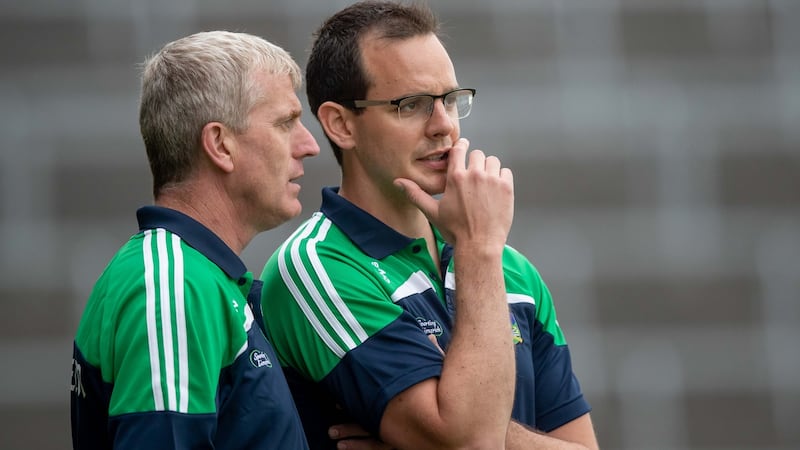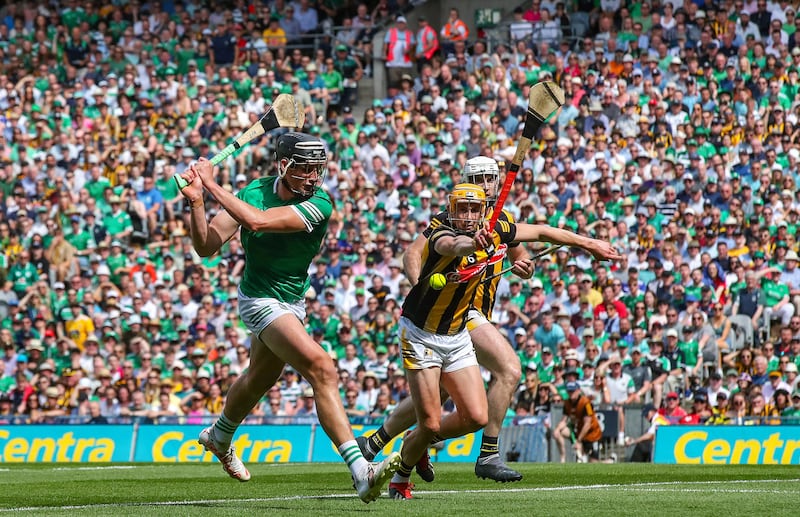If every All-Ireland final has an appointment with history, not all of them can hold history’s attention. On Sunday Limerick are gunning for their fourth All-Ireland in-a-row, a feat that has only been achieved twice in hurling. Standing in their way are Kilkenny, stony-faced, like the Garda that has walked into a late-night lock-in, asking for names.
Greatness needs a context and it must be harassed. When Kilkenny’s four-in-a-row team reached their summit in 2009 it seemed like they had out-run every plausible rival from the halls of time. We wondered if we would ever see their like again, and didn’t dwell on the absurdity of the question. But here we are, glued to the stop watch, half-expecting another world record.
In sport, conversations about better and best are often circular and usually insoluble. In this case, how could you begin to measure the Cork team of the 1940s that won four-in-row, and five All-Irelands in six years, against the juggernauts of the modern age? Hurling was a different species then.
The current Limerick team and the greatest team of the Brian Cody era are separated in time by not much more than a decade, but the game has experienced so many tactical convulsions and cosmetic surgeries in that period that ball-for-ball comparisons are treacherous too. That doesn’t stop the talk.
Malachy Clerkin: The GAA should make more of St Patrick’s Day - and more of its intercounty stars
Shefflin trying to devise a way for Galway to halt Limerick juggernaut
Munster CEO defends broadcast coverage of province’s hurling championship
Sports Review 2023: Murphy’s incredible reflex save showed hurling’s facility for the impossible
The greatest team of all time is a contested space again. The common ground is not hard to stake out: livid aggression; dominance in the air; the capacity to execute every skill under withering pressure; tackling and turnovers, at industrial levels of output.
The Kilkenny four-in-a-row team were exemplars of defending from the front. In that zone they created a force field. It was so fundamental to their identity, and their success, that every other team was forced to adopt it as a basic performance metric.
In all sports, evolution and imitation are never divorced. When Kilkenny look at Limerick they see a flattering resemblance. On the live RTÉ broadcast of last year’s final, Anthony Daly suggested that swarm tackling had been introduced to hurling by Paul Kinnerk and Limerick, when surely it started with Cody and Kilkenny.
Cody wasn’t concerned about trends or statistics; Limerick feast on data. The numbers say that more than 90 per cent of matches are won by the team whose forwards make the most tackles. Limerick are bound to that target; Kilkenny invented the dynamic.
The greatest thing they have in common, though, is culture. Players who have retired from the Limerick squad in recent years have described a training environment calibrated to be more demanding than anything they will encounter in a match. That is precisely what Cody created in Nowlan Park.
For that culture to work, though, it needs to be self-sustaining and self-regulating. The players are answerable to a higher authority, of course, but the group is the whetstone on which the knife is sharpened. Peer pressure drives it.

In 2017, Kinnerk’s first year as Limerick coach, he made a presentation to the GAA’s coaching conference in Croke Park. One of the themes he teased out was a “player-centred approach.” In the course of that he spoke about the All Blacks, and the period when they kept messing up at World Cups.
In New Zealand the causes were interrogated at length, in every forum imaginable, and one of the simple conclusions they reached was that they needed to find “more intelligent players, with enhanced perception, and better decision-making skills.”
In Limerick that was their headline mission. Much is made of Kinnerk’s capacity to problem solve in real time during a match, and it was celebrated again when Nickie Quaid halted play in the semi-final, and Kinnerk issued some instructions. But inflating that kind of intervention offers no understanding of what Limerick have created.
“The point I’m getting at is we should be handing players responsibility,” said Kinnerk in 2017. “It shouldn’t be a case that the coach is expected to do everything. If you do everything for them on the training ground it would be no surprise if they weren’t able to fend for themselves in a match. We know we’re in trouble if they’re looking over [to the side line] for coaching.”
In this championship, more than any other since their breakthrough in 2018, Limerick have leant on their capacity to problem-solve. Not every solution was perfect, or instant. In their draw against Tipperary they led for less than five minutes. Against Cork and were outscored by 1-6 to 0-3 after the 60th minute.
In that game, they nearly blew a seven-point lead; against Waterford they allowed an eight-point lead to evaporate. Galway led them by six points in Croke Park. Clare beat them in the round robin. This summer, we saw them through a different lens.
At their best over the years Limerick were implacable and efficient and relentless, and sometimes their play was so drilled and polished that it seemed like emotion had been skimmed off, like the froth on a pint. This year they have looked fallible. As if the machine had been made flesh.
Yet here they are, buoyed by the best 40 minutes they have played in this year’s championship, their stare fixed on another summit.
Are they vulnerable? They must do without Sean Finn, their best inside defender, and Declan Hannon, their centre back and captain and compass. They managed against Galway. The counterweight is how much trust they have in a core of group of battle-hardened, stress-tested players. In the four finals that Limerick have won they have used just 18 different starters; on the bench, though, the churn has thrown up 23 different names.
David Reidy has worn number 25 in three finals and wore number 26 last year; he starts a final on Sunday, at 30 years of age, at last. In a sense, somebody like him exemplifies the culture. Being an impact sub requires a certain kind of mentality and stamina. He didn’t surrender to that role; he kept going until they seen him differently.
In their best years under Cody, Kilkenny were hurling’s Sphinx: nobody could answer their questions and everyone was afraid of being eaten. They are a different beast now, though wedded to all the same principles. There is still no end to them.

Kilkenny were good in last year’s final, but it is impossible to watch that match again without concluding they will be better on Sunday. They will get more from Eoin Cody and Adrian Mullen; their half-back line won’t be dismembered. A year ago they decided not to man-mark Gearóid Hegarty; he scored 1-5 from play and claimed a staggering nine puck-outs. They won’t make that kind of mistake again.
Kilkenny are the last team to beat Limerick in a knockout match, four years ago now. They eliminated Limerick from the 2017 championship too, John Kiely’s first as manager. Limerick scored just 17 points that night in Nowlan Park, and committed 17 wides. Those numbers had no prospects.
Afterwards Kiely fumbled with his emotions, not wanting to take anything from a loss. “But listen,” he said, “we’re building something strong and sustainable. It’s there for the future.”
That time came. It led them here.















